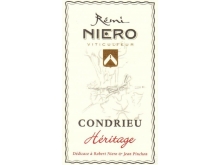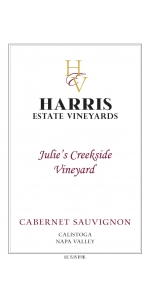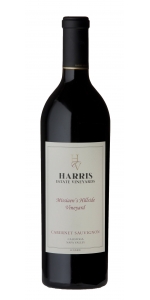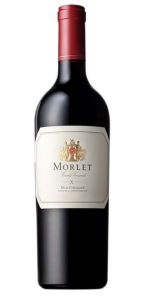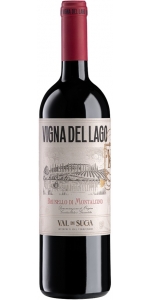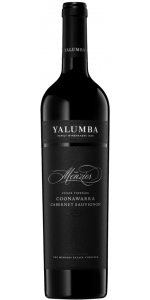Remi Niero Condrieu Heritage 2018
| Country: | France |
| Regions: | Rhone Condrieu |
| Winery: | Remi Niero |
| Grape Type: | Viognier |
| Vintage: | 2018 |
| Bottle Size: | 750 ml |
Heritage School Julies Creekside Cabernet Sauvingon is made from 100 percent Cabernet Sauvignon.
The Cabernet Sauvignon Julie’s Creekside Vineyard is an impressive, opaque purple colored wine that is super-concentrated and extracted with relatively sweet tannins, a touch of chocolate and espresso, a full-bodied mouthfeel and pure, dark, primordial fruits. This is a big, masculine, concentrated wine set for long-term aging. Saying that, it has a certain accessibility, but won’t hit its prime for at least another 8-10 years and keep 25-30.
Review:
"The 2014 Cabernet Sauvignon Julie's Creekside Vineyard is dark, sumptuous and surprisingly open-knit for such a young wine. Black cherry, plum, game, rose petal, sage, smoke and earthy notes underpin a core of intense dark red cherry and plum fruit. Soft contours and generous, super-ripe fruit add to the wine's near and medium-term appeal. - Antonio Galloni"
- Antonio Galloni's Vinous (December 2016), 93 pts
Heritage School Missiaens Hillside Cabernet Sauvignon is made from 100 percent Cabernet Sauvignon.
A steep, rocky site with red volcanic soils results in our most structured and concentrated wine. Planted in 1998 using 110R rootstock and clone 337 Cabernet Sauvignon our Hillside Vineyard produces wines as breathtaking as the views from its slopes. These tiny, dark blue berries ripen near the end of September thanks to cool afternoon temperatures allowing for increased hang time and developed flavors.
Reviews:
"The 2014 Cabernet Sauvignon Missiaen's Hillside Vineyard is the darkest and richest of these wines, but it also has enough structural breadth to handle all of that intensity. Superripe plum, bittersweet chocolate, tobacco and licorice all flesh out over time. This is an especially rich, seamless style, yet all the elements are in the right place. - Antonio Galloni"
- Antonio Galloni's Vinous (December 2016), 92 pts
Inglenook Rubicon is made from 88% Cabernet Sauvignon, 8% Merlot, 3% Cabernet Franc, 1% Petit Verdot
Since its inaugural vintage in 1978, Rubicon has been the Estate's premier red wine, reflecting the soul of the property and expressing Francis Coppola's wish to create a Bordeaux-styled grand wine, that is, "a wine that can please contemporary taste, but with a historical aspect [that defines] our vineyards at their zenith."
Rubicon was named after the small river crossed by Julius Caesar in 49 B.C., declaring his intention to gain control of Rome, thereby launching a civil war among opposing factions. Over time the phrase "crossing the Rubicon" has come to signify any irreversible action with revolutionary intent or the outcome of which holds great risk. True to its uncommon depth, Inglenook's Rubicon continues to be a testament to the finely tuned rendering of a risk well-taken.
Strikingly rich in color and extract, the 2018 Rubicon is unquestionably a precocious, hedonistic wine. The exotic, well-knit aromas and flavors include ripe cassis, allspice, star anise, vanilla and black licorice. Upon entry, this full-bodied wine envelops the palate with its luxurious concentration and supple, silky tannins, supported by vibrant freshness from the balanced acidity, and perfectly-integrated French oak. Very long and expansive in the finish, the 2018 Rubicon will be memorable for decades to come.
Review:
Subtle and complex red with blackberry, black truffle, sweet tobacco and mahogany. Highlights of lavender and violets. Full-bodied and very tight with finesse and tension. Very polished, fine tannins. Long finish. Delicious already, but best after 2022.
-James Suckling 97 Points
Morlet Family Vineyards Mon Chevalier Cabernet Sauvignon is made from Cabernet Sauvignon (86%) Cabernet Franc (8%) Merlot (3%) Malbec (2%) Petit Verdot (1%) .
Located on the hillsides of Knights Valley, near Calistoga, this vineyard benefits from its proximity to Mount St. Helena, whose warm and windy climate is ideal for the long ripening of the Bordeaux red varietals. Handcrafted by using classical winemaking techniques, this special wine is dedicated to our son, Paul Morlet.
Dark red with a hue of purple. Intense and complex bouquet of red, black and blue berries intermixed with notes of blueberries, minerals (graphite, wet river rocks) licorice, fresh blond tobacco and a hint of lavender. Full bodied, the palate is reminiscent of the nose, with a richly tannic yet round frame and a great intensity. The hillside tannins and the classical aromatic complexity create a harmonious ensemble, leading to a very long and elegant finish. Built to age for decades, this collectible wine opens up after a few years of cellaring and is particularly representative of this special vineyard from the hillside of Knights Valley. Mon Chevalier features the interaction of the loamy, well drained and rocky volcanic soil, the typical sunny mountain climate and the low-interventionistic Morlet winemaking approach.
Property Name: Mon Chevalier
Name Meaning My Knight Named after our son, Paul Morlet
Type of wine Vineyard designated
Appellation Knights Valley
Vineyard singularity Morlet Family Estate Hillside 1100-1200 feet elevation Rhyolitic, loam & volcanic ash
Typical harvest date End of October
Picking Manual, small lugs, refer truck
Sorting Cluster by cluster, berry per berry
Fermentation Through native yeast Tank and Puncheons
Upbringing 16 months French oak from artisan coopers
Bottling Unfiltered
Cellaring time Decades
Serving Room temperature
Decanting recommended
Review:
The 2018 Cabernet Sauvignon Mon Chevalier comes from the Knights Valley, just north of Napa Valley in the larger Sonoma County, and it always seems to me to have one foot in Napa and one foot in Sonoma. Boasting a similar ruby/purple color (as do all of the releases here), it’s slightly more reserved and stately (knightly, if you will), with building aromas and flavors of blackcurrants, toasted bread, dried violets, baking spices, and loamy earth. These carry to a pure, full-bodied, multi-dimensional Cabernet that’s flawlessly balanced, has ripe yet certainly present tannins, a notable sense of minerality, and a great, great finish. It’s just another incredible wine from Luc Morlet that can be drunk today with ample pleasure or cellared for 20-30 years if, for some reason, you feel the need to delay gratification.
-Jeb Dunnuck 99 Points
Influenced by the northeastern side and the features of the terroir, Vigna del Lago is an elegant, light and sapid Brunello. It exhibits a distinctive, slightly pale, ruby-red colour and notes of ginger, cherry, orange peel, bitter orange and dried flowers. Medium-structured, silky and delicate tannins with a slightly salty finish.
Vigna del Lago is located on the northeastern slope of Montalcino, which is influenced by a continental climate, with harsh winters and very hot summers. The surrounding nature is reminiscent of the Crete Senesi, with hills and cypresses and a lovely lake next to the vineyards. The soils are clayey.
Ageing takes place in a dedicated cellar, 24 months in 40-hl Slavonian oak barrels, followed by 6 months in concrete and 9 to 12 months of bottle maturation.
Review:
This 2018 Val di Suga Brunello di Montalcino Vigna del Lago is looking really beautiful in this 2018 vintage. The nose is bright with delicate, fragrant rose and ripe strawberry notes. The palate has a very tangy, juicy acidity and plenty of savory, fine-textured tannins. There is a sublime texture with that wonderful quality of weightless harmony. This is a lovely wine that just feels very gentle and flows across the palate like a little wave.
-Wine Independent 97 Points
In 1992 the Hill-Smith family counted themselves amongst those fortunate enough to own a vineyard upon the famous Coonawarra terra rossa soil over limestone. Experimentation, innovation, minimalist intervention and small batch winemaking has resulted in The Menzies’ reputation as a wine of longevity, elegance and structure.
Situated in the heart of Coonawarra’s terra rossa strip, The Menzies Estate vineyard lies on a flat plain, approximately 70km from the coast. Given the terrain and influence of the cooling Bonney upwelling, Coonawarra is an ideal location to grow premium Cabernet Sauvignon. Our soil is red sandy loam over limestone, which is classic Cabernet Sauvignon country. The grapes for The Menzies 2017 are from vines planted in 1994 and 1996. Bunches are usually small with small berries, giving concentration via an ideal skin to juice ratio favouring the making of fullbodied reds.
Experimentation, innovation, minimalist intervention, and small batch winemaking has resulted in The Menzies' reputation as a wine of longevity, elegance, and structure.
Aromas of fresh rosemary, mulberry, violets and exotic spices. Take a sip and you will feel the poise and tension for which great Cabernet is renowned. A wine of great complexity with flavors of blackcurrant, bitter chocolate, and mulberries, wrapped in divine tannins and a lovely sweet, dark fruit finish. With decanting in its youth, it is enjoyable as an elegant full-bodied red wine.
Review:
The 2018 The Menzies Cabernet Sauvignon is luscious and velvety in the mouth, with a lustrous core of shimmering purple Cabernet fruit. The tannins are typical of Coonawarra in that they are firm, yet they are seamlessly inlaid into the fruit, which feels as if it spills over the edge of the glass. Seductive but rigid, it will have a long life in front of it, make no mistake. You get cassis, resin, licorice, raspberry, gravel/iodine, bay leaf, dark chocolate, after dinner mints (the only brand to be had is the After Eight mints, of course), and notions of cedar spice. Brilliant. 14% alcohol, sealed under cork.
-Wine Spectator 95 Points
Remi Niero Condrieu Heritage is made from 100% Viognier
The wine is a pure expression ot the terroir. A deep and brillant golden color, the wine is charming and well-balanced offering an enticing nose of fresh white fruits and flowers. Smooth and rich on the palate with great concentration and complex flavors supported by a hint of minerality that brings freshness and finesse to the wine. A long and elegant finish.
Vines are 30 years old on average.
Pneumatic pressing.
Alcoholic fermentation in temperature controlled stainless steel tanks.
50% of the wine is aged in French oak barrels for 12 months and the other 50% is aged in stainless steel tanks.
Batonnage (stirring of the lees)
Malolactic fermentation
The wine pairs well with salmon carpaccio, scallops, foie gras, pork loin with curry sauce, delicate Asian food, goat cheese.
Remi Niero Estate
It is on terraced hillsides that the Domaine Niero harvests the best grapevines of Viognier and Syrah to offer unique vintages of Condrieu and Côte-Rôtie.
Culture ways:
Caring about environment, your wine grower has resorted to thoughtful working methods in the vineyard so as to develop a responsible wine growing . Moreover, aware of the need to adapt his culture policies, he has recently resorted to organic farming.
Date Founded: 1973
As vintage wines from the northern Rhône Valley, my vintages reflect our passion and are the fruits of a genuine know-how, a legacy from both my father and my grandfather. I invite you to discover the typical aspects of my wines, which I’ve worked on while keeping up the tradition and respect of our environment to make them the finest and the most unique vintages.
Either in Condrieu or in Côte-Rôtie, each type of vine (Viognier or Syrah) fully expresses itself according to its favourite soil. Endowed with a great open-mindedness further to my numerous visits through worldwide vineyards, I strive to make my wines delicate, structured and unique products. From the vineyard work to the wine-making process, my team and I have done our best to get the perfect maturity and the quintessence of aroma in order to offer the wines that wonderfully reflect our outstanding soil."
Rémi Niero
Condrieu and Côte-Rôtie wine grower
Now at the head of the vineyard , Rémi Niero has taken over from his father Robert, who, from Rémi’s early age, has passed on to him his whole know-how and passion for wine growing. The latter had taken over a small vineyard from his father-in-law Jean Pinchon in 1985, planting and working hard in those “chaillets” to make one of the most beautiful landscapes of our shared patrimony look more beautiful. Despite the requirement of this soil, his efforts have been rewarded by the authentic and natural balance of the wines.
To honor his masters Robert and Jean, Rémi offers his new vintage « Héritage» ,which is particularly faithful to the know-how and identity of the domain. Taken from the selection of the most beautiful casks of Condrieu, it will charm your taste buds and those of your guests.
Remi Niero Côte-Rôtie vineyard:
History:
It is one of the oldest vineyards in France. The Romans developed it and later, during the Middle-Age, a legend says that Lord Maugiron shared his good between his two daughters, one brown-haired and the other blond-haired,hence the names that the wines have kept , Côte Brune and Côte Blonde. Côte-Rôtie is the domain of the Syrah vine, which is broad and manly. A small place has been given to Viognier (20 % maximum allowed in the blend) which can bring a more feminine note.
Soils and climate:
The vine is harvested on grape-pickers’ backs on very steep granitic hillsides called “chaillets”, hold back by stone walls. The climate is the same than in the Condrieu vineyard. Rémi and Robert Niero’s Côte-Rôtie comes from two parcels over two hectares : La Viallière and Le Côteau de Bassenon (the southernmost parcel of the label).
- back
Filippino Elio Barbaresco San Cristoforo Riserva 10 Anni is made from 100% Nebbiolo.
This Riserva 100% Nebbiolo is produced on the hillsides of the San Cristoforo vineyard in Neive. A beautiful wine, full of fruity aromas, violet and raspberries, along with spicy hints of cinnamon, tobacco and vanilla. Full-bodied and elegant with intense flavors.
The best grapes are delicately pressed and the stalks are removed. The must ferments in stainless steel vats at a controlled temperature of 26°C with a maceration of 25 days. After racking, the new wine is put into 15-25 hl Slavonian oak casks for long months. Next, it is bottled and left to age for at least 7 years. The tenth year the wine is ready for the market.
A balanced and memorable Chardonnay that starts with aromas of orangeblossom, Asian pear, crème fraiche, peaches and chamomile, complemented bynotes of toffee, honeysuckle, and graham cracker. On the palate, flavors of greenapple, Meyer lemon and stonefruit are finished with notes of tangerine and vanilla.This Chardonnay is smooth, creamy and balanced with a lingering acidity and a longfinish. This is the perfect wine to pair with a brie or gouda cheese plate drizzled withlocal honey and hazelnut.
Review:
Fruit is sourced primarily from the southern part of Napa Valley, and aged five months in French oak. With its billowy mouthfeel, the liquid seemingly floats above the palate. Lemon curd, daffodil, cinnamon toast, and creamy vanilla sandalwood are delicious and generous flavors. This is approachable luxury. - The Tasting Panel, July/August 2025
-Tasting Panel/Somm Journal 92 Points

